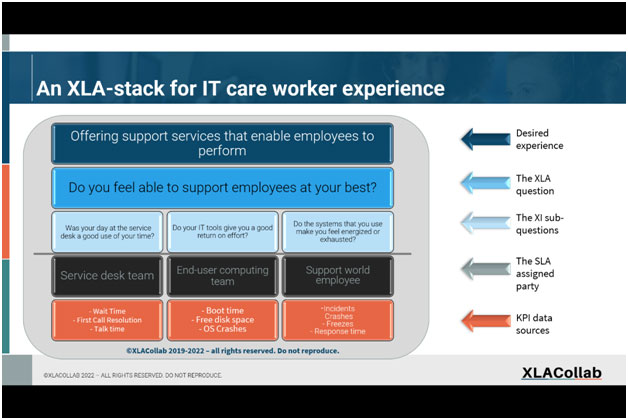The world is firmly transitioning from the Service Economy of the 80s and 90s to The Experience Economy. In 2021, Wills Tower Watson found that 92% of enterprise leaders say experience management is a priority.
In the Experience Economy, employee, supplier, and customer experience is the most significant contributor to business economic value. Revenue, Market Share, Productivity, Innovation, and Customer Loyalty.
How can it be that in the Experience Economy, where enterprises live or die by their employee, supplier, and customer experience, those experiences are often so woeful?
In this article, I suggest that the CX world is failing because of its faith in fallacies inherited from the service economy.
I will then discuss how an XLA (Experience Level Agreement), a promise to deliver on a defined experience, is the basis for modern experience management.
Digital Anthropologist and Experience Guru Aarron Spinley states, “It’s time to think differently. But to do that, we first have to understand who we are, the pull of the future, the push of the present, and the weights of the past.”
Less than 10% of enterprises have an integrated experience management strategy grounded in technology. If you are still measuring NPS and customer satisfaction as an indicator of experience, pay attention and read on. Not only are you wasting your money, but you are putting your enterprise at risk.
Even though we have invested in skilled CX teams, they are often used ineffectively. They are insufficiently connected to the business value of experience.
Let’s find ways to make your CX professionals more successful. Firstly, jettison the weight of the past. Let’s look at six common CX fallacies from the service economy that we continue to pursue:
ROI and Time Value of Money as vital economic measurements.
ROI is a hangover from the Industrial Economy and Time Value of Money from the Service Economy. Both are still useful but tragically over-rated because they are so poor at dealing with As-A-Service models and how consumers actually value experience.
The most crucial metric in the Experience Economy is The Money Value of Time. A concept introduced by Pine and Gilmore in their book, The Experience Economy.
Experience is measured in transactions.
Experience is not measured in single transactions but cumulative moments over time. This is why NPS and CSAT surveys fall short as an experience indicator. Quite frankly, what does your NPS score tell you?
Surveys are an accurate measure of sentiment.
Most surveys are poorly constructed, unscientifically fabricated, with questionable reporting accuracy. A survey is only helpful if it is anchored in separate sources of empirical data. In a recent survey by XLA Collab of 250 enterprises, 88% used Customer Satisfaction surveys (CSAT) as the preferred method of gathering information. 77% found their surveys to be of little actionable use.
Customer satisfaction equals experience management.
Customer Satisfaction is about the acceptance or rejection of a transaction. Did the agent solve your problem to your satisfaction? Customer experience is about how you make people feel. When they look back on their interaction, how will they remember it? Joe Pine says, “memories are the hallmark of the experience.”
Experience is a constant baseline that we improve over time.
Human beings are self-programming sensors. So, they constantly adjust their expectations and reactions. This means that a consistent level of service will generate an inconsistent set of experience results. This is even more likely over time. We refer to this as the gravity enigma. Experience is subject to the gravity of expectations and, in extension, the gravity of perceived performance.
Experience is based on psychology.
Experience in an enterprise is not about individuals; it is based on anthropology and, specifically, digital anthropology. To be crude, as an enterprise, we don’t care why Sally or Arthur feel the way they do; we care THAT they feel the way they do. We are not so concerned with Sally or Arthur, but we care about everyone, LIKE Sally and Arthur. Experience management in an enterprise is a scale business.
So what about XLAs?
The Experience Level Agreement was first invented by the Innovation Transformation Strategist Marcel Broumels in 2007. The XLA pulls together the essential layers of an experience to make it a defined and manageable proposition.
The XLA starts with the experience that an enterprise wishes to stage. This could be a car showroom experience, a service-desk interaction, an onboarding process, or even the experience of patients and staff in an emergency room. We then disassemble the staged experience into sentiment aspects, experience indicators, service components, and key performance indicators.
The XLA, or XLA stack, enables us to define, measure, monitor, guarantee and improve the experience. Here is an example of an XLA stack for an IT care work supporting employees (a call center agent or a service-desk team member)

The XLA is an essential component of your experience management strategy because:
- It focuses on how people experience outcomes.
- It links the experience to the business economic value
- It uses empirical experience indicators to gather and validate the sentiment
- It focuses on doing what matters rather than doing what is expected or contracted
- The XLA considers the context of human wants and needs
- The XLA builds on operational data in SLAs and KPIs
- An XLA is built to deal with the gravity enigma of expectations and performance.
Success in the experience economy means a relentless focus on the economic value of an employee, supplier, and customer experience.
To achieve that, we must combine CX, UX, BX, and EX talent. We need to build on what we know, evolve beyond what worked in the service economy, and consider XLAs an essential linking pin in our toolkit to achieve integrated experience management across the enterprise.

















